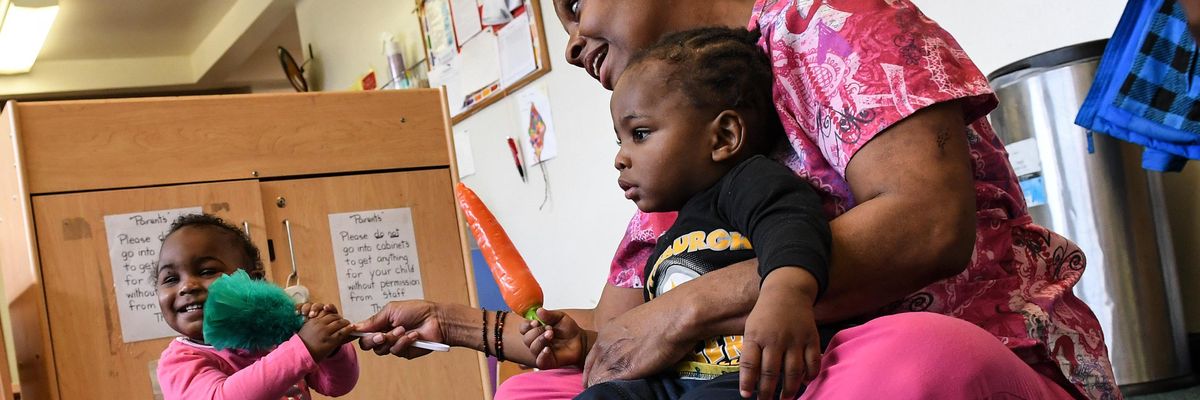The American Rescue Plan Act of 2021 created a $350 billion fund to help state and local governments mitigate the Covid-19 pandemic and facilitate economic recovery. Nearly two years later, however, more than $150 billion remains unspent even as employment in the public sector and caring professions remains below pre-pandemic levels.
Dave Kamper, a researcher at the Economic Policy Institute (EPI) and 20-year veteran of the labor movement, argued Wednesday that states and cities should use tens of billions of dollars in untapped relief money to reconstruct the public sector and strengthen the care economy.
"The ARPA dollars earmarked as part of the State and Local Fiscal Recovery Fund (SLFRF) have fueled transformative investments across the country, but there's more to be done now," Kamper wrote in an EPI blog post.
"A return to the pre-pandemic status quo is not sufficient."
"As 2023 begins, state and local governments should prioritize spending relief funds on... rebuilding the public sector; expanding access to paid leave; and bolstering our systems of care through increasing access to quality childcare and eldercare, and supporting the workers who perform that work," Kamper continued. These are "three critical areas that are incredibly important for the welfare of children and families."
As shown in the map below, the 10 states with the lowest uptake of SLFRF dollars have each spent less than 7.5% of their allotted funds.
"It's not clear why those states have not yet made significant use of the money," wrote Kamper, though he noted that "all 10 states have Republican governors and Republican-controlled state legislatures."
Another tab in the map depicts significant public sector job losses nationwide since the emergence of the coronavirus.
"While private sector employment has exceeded pre-pandemic levels, public sector employment is still far below February 2020 levels," Kamper wrote. "In December, there were 452,000 fewer workers in the public sector than before the pandemic, and state and local governments in particular have 2.3% fewer workers than before than pandemic."
"Fully half those losses are in K-12 public education," he continued. "Not only are flourishing public schools necessary to the long-term well-being of children and communities, but it's also the case that parents can't easily reenter the workforce if safe and nurturing schools aren't available."
Noting that "state and local governments never fully recovered from the Great Recession of 2008-09" thanks to an ill-advised bipartisan austerity regime throughout the 2010s, Kamper stressed that "a return to the pre-pandemic status quo is not sufficient."
According to Kamper, "The shortfall in state and local government jobs is driven in large part by the inadequate wages paid to public sector workers."
As he explained:
Fully one-third of state and local government workers are paid less than $20 an hour, and 15% are paid less than $15 an hour. Black and Latinx employees are especially likely to be paid inadequate wages in the public sector, which also employs a disproportionate share of women workers. These workers need a raise, and state and local governments will need assistance in raising pay for their workers. Meanwhile, the teacher pay penalty has hit a new high: Teachers are now paid 23.5% less than comparable college-educated, non-teaching peers.
Fortunately, a solution is in sight, Kamper pointed out: Rather than continuing to sit on "substantial SLFRF dollars," policymakers "can and should" use these funds "to increase public sector pay and fill vacant jobs."
Kamper went on the make the case for investing idle SLFRF money to expand paid sick and family leave—a popular and lifesaving policy that is currently denied to most of the country's worst-paid private sector employees—and to boost care worker wages.
Low wages in the care economy, where "women and Black and Brown workers make up a disproportionate share of the workforce," are a key reason why "only 76% of the childcare service jobs lost during the pandemic have been recovered" and why there were nearly 300,000 fewer employees nursing and residential care facilities in November 2022 than in February 2020, Kamper observed.
"The needs of today demand action."
"It is unlikely that federal policymakers will enact significant new paid leave policies in 2023, nor can we expect substantial new federal investments in childcare, domestic healthcare, or long-term residential care" given the current makeup of Congress, Kamper wrote. "State and local governments can and should use SLFRF dollars to fill the gap, providing needed supports to working families and children."
"State and local governments, which spent so much of the Great Recession dealing with the consequences of austerity policies that ravaged public services, may very well be reluctant to spend down their still-ample SLFRF balances," he acknowledged. "There is, however, no better time than the present."
"The needs of today demand action," Kamper concluded. "State and local governments have more than $150 billion left to spend, and there is no better use than spending the money on transformative investments that can restore the public sector and provide vital help to low-wage workers and their families."
